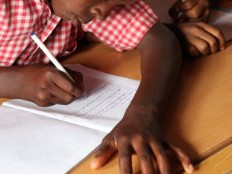|
||||||||||||||||||
|
|
Haiti - Reconstruction : (III) Education - Strategic Plan 06/01/2011 08:56:41
While donors begin to fulfill their pledges and have difficulty accessing the facts about what is needed most on the ground, many are asking how to prioritize their spending. The strategic plan presented at the fourth meeting of the IHRC, December 14, 2010 at Santo Domingo in the Dominican Republic, will help guide the project implementers, donors and investors as they guide the disbursement of their pledges for the reconstruction and development of Haiti, and add much needed new funding. Developed jointly by the Commission, international experts and ministry leaders, this plan outlines many of the most important things needed in Haiti by October 2011, the end of IHRC’s mandate. Each day of the week we'll discover a part of this strategic plan for 2011. Today we cover the education. This strategic plan is based on the Five-Year Plan of the Government that was finalized through a joint effort of the Government, the Presidential Commission on Education and main donors. Overall, 10 years after the launching of the National Plan for Education in 2000, and despite a substantial increase in the number of schools and students, the national system continued to be characterized by:
The impact of the earthquake is well known and has been described in the PARDN. For instance, in the West Department, which receives 50 percent of entire caseload, 80 percent of all structures were destroyed or damaged, representing some 3,804 schools. On the human side, several thousands of students died, together with approximately 1,350 teachers and 180 non-teaching personnel. In the South East, 279 schools were destroyed or damaged. All vocational training centers of the country were either destroyed or severely damaged. Over 80 percent of the national university structures were seriously affected or totally destroyed. In a context where everything is to be done, a stringent prioritization exercise was undertaken which prioritized primary schooling that would benefit the majority of the young Haitians. The Five-Year Plan and more immediately this present plan need however to remain ambitious so that Haiti does not face yet another lost generation, in a country that places education very high in the priority of the households, regardless of the income. Targets, rationale and programs The short-term objectives are therefore in line with the longer-term ones, notably free and compulsory access to quality education, and in particular the first 9 educational years as of 2021. Secondary and tertiary levels, vocational training and specialized education are also important components of the Five-Year Plan although they do not feature in the short-term at the same level as basic education. The Five-Year Plan’s overall requirements have been estimated at some $4.3 billion. It is estimated that Haiti will be able to cater for 25 percent of its needs and therefore a major international effort will therefore be required over many years. Priority will go in a first phase to rebuild, better, what was destroyed by the earthquake and build new schools in areas that had none to date. An equal priority will be given to fill the gap between expenditures and needs in the short and longer term, keeping free education for the first 9 years in particular as the goal to attain within 10 years. In parallel special efforts will be devoted to improving the governance of the education sector as a whole. This includes strengthening the ministry’s capacity to plan, supervise and train, while increasing the State’s capacity to provide schooling to its young citizens. The reality on the ground and the ambitious objectives of the country meet in the specific goals that will need to be reached by the end of 2011, namely: Infrastructure and equipment for fundamental schools
Vocational training
Literacy
Tertiary education
Governance/support to the MENFP (including infrastructure)
Others
Funding requirements The gap to implement this short-term effort stands at US$ 152.6 million as follows: Sub-category Gap Cost ($152.6m (2)) - Infrastructure and equipment for fundamental schools $50m - Vocational training $25m - Literacy $4.6m - Tertiary education $15m - Governance/support to the MENFP (including infrastructure) $56m - Others $2m (2) Does not include school feeding, financial assistance to children and supply of kits to children and teachers A major effort had already been undertaken in the spring and summer of 2010 to ensure that as many children as possible could return to school for the autumn semester 2010. Although dozens of thousands of students have benefitted from efforts on this front, over half of the total requirements remained unmet. Meeting the objectives outlined above will create a virtuous circle: an increasing number of children will be able to attend school, including many who were never able to attend; over 10,000 temporary jobs will be created in the construction activities and several hundred permanent jobs will be created for the new schools to be built. Local produce will be purchased for school feeding that will help improve farmers’ income both in the short and long terms. The financial burden on poor households will be decreased through more public schools and increase in the number of children receiving financial assistance, thus decreasing the vulnerability of the poorest. See also: https://www.haitilibre.com/en/news-2033-haiti-reconstruction-i-housing-strategic-plan.html https://www.haitilibre.com/en/news-2040-haiti-reconstruction-ii-debris-removal-and-management-strategic-plan.html https://www.haitilibre.com/en/news-2054-haiti-reconstruction-iv-health-strategic-plan.html https://www.haitilibre.com/en/news-2062-haiti-reconstruction-v-energy-strategic-plan.html https://www.haitilibre.com/en/news-2066-haiti-reconstruction-vi-job-creation-strategic-plan.html https://www.haitilibre.com/en/news-2073-haiti-reconstruction-vii-water-and-sanitation-strategic-plan.html https://www.haitilibre.com/en/news-2082-haiti-reconstruction-viii-reinforcement-of-institutions-strategic-plan.html HL/ S/ HaitiLibre /CIRH
|
|
|
Why HaitiLibre ? |
Contact us |
Français
Copyright © 2010 - 2024 Haitilibre.com |



